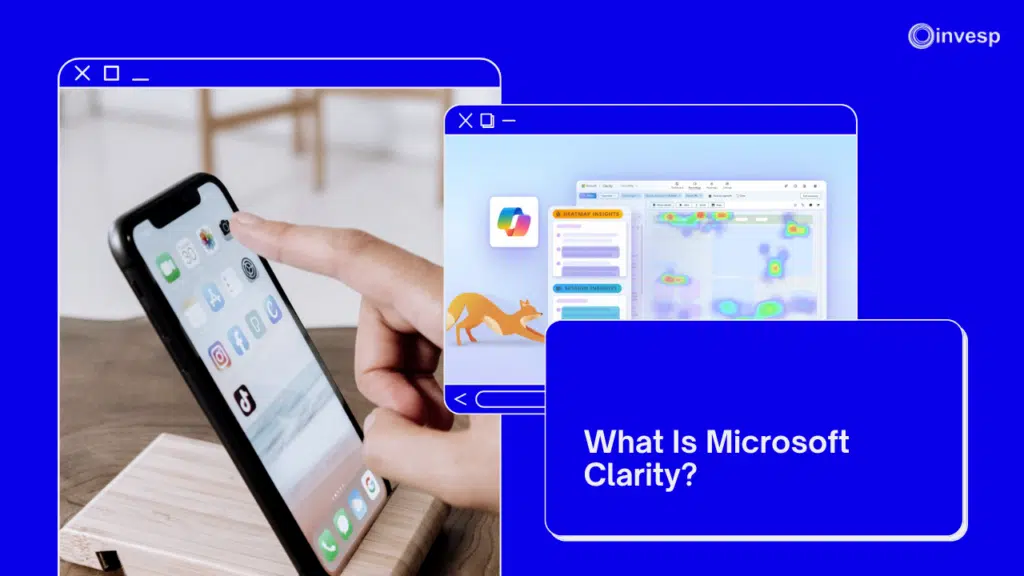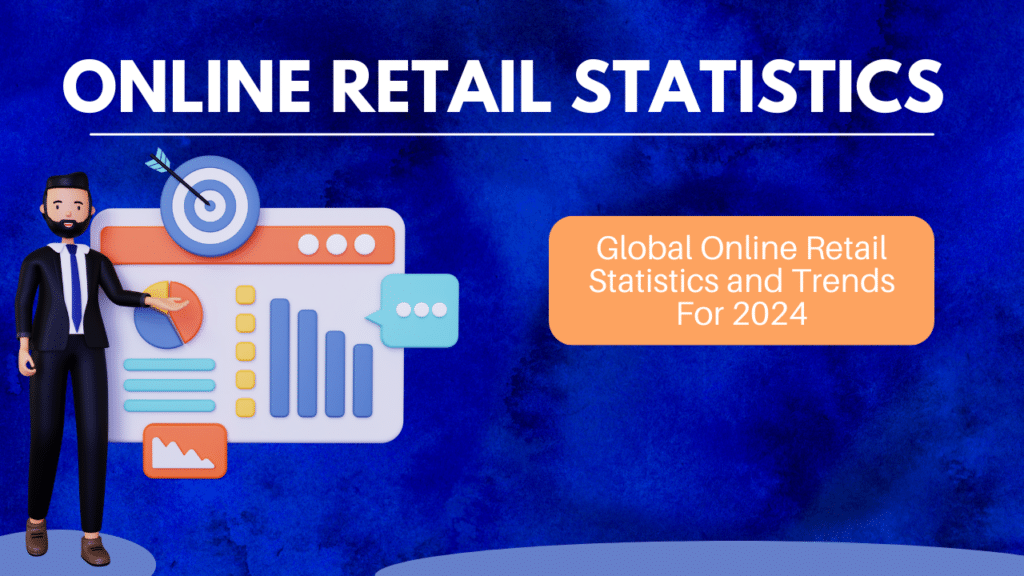In the early 2000s, PepsiCo ran blind taste tests that showed most people preferred Pepsi over Coke. Confident in the data, they launched a bold campaign but it backfired. Sales didn’t spike. In fact, Coke pulled ahead.
Why? Because marketing isn’t just about the product. It’s about memory, identity, emotions—things you can’t always measure.
That’s why the best marketing books don’t just teach tactics. They teach you how people think. And in 2025, as AI tools flood the landscape and automation handles the busywork, your edge comes from knowing what still can’t be outsourced: human insight, strategy, and brand intuition.
This list brings together some of the best marketing books for today’s post-SEO world.
We’ve organized the 31 best marketing books into clear, purposeful categories, so you can jump straight to what matters most for your role, goals, or curiosity.
- Marketing Classics & Timeless Strategy: Essential reads on brand positioning, copywriting, and the fundamentals that never go out of style.
- Consumer Behavior & Persuasion: Understand the psychological drivers behind buying decisions and how to influence them ethically.
- Content Marketing & Storytelling: Books to help you craft stories that build trust, spark action, and grow your brand.
- Social Media & Direct Response Marketing: High-impact strategies for engagement, ROI, and platform-specific growth.
- Strategy, Innovation & Category Design: Forward-looking reads on long-term growth, market disruption, and owning your niche.
- Marketing in the Age of AI: Navigate automation, generative tools, and the future of marketing in an AI-driven world.
Each book in this list will sharpen your thinking, upgrade your strategy, and help you stand out—whether you’re a beginner, a brand builder, or a digital native navigating the noise.
TL;DR: The Best Marketing Books of 2025—What to Read and Why
-
Positioning by Al Ries & Jack Trout -> For mastering brand perception and competitive messaging
-
Ogilvy on Advertising by David Ogilvy -> For persuasive copy and ad fundamentals that still work today
-
Good Strategy, Bad Strategy by Richard Rumelt -> For building clear, focused marketing plans
-
Influence by Robert Cialdini -> For using psychology to make your campaigns more persuasive
-
Epic Content Marketing by Joe Pulizzi -> For creating value-first content that converts
-
Everybody Writes by Ann Handley -> For improving your writing across all channels
-
Marketing Artificial Intelligence by Paul Roetzer -> For using AI tools without losing the human touch
-
Conversion Optimization by Khalid Saleh -> For turning traffic into actual sales through better UX and copy
-
Contagious by Jonah Berger -> For designing content and offers, people naturally share
-
The Age of Invisible Machines by Robb Wilson -> For building AI-powered customer experiences
I. Marketing Classics & Timeless Strategy
These are the books that shaped modern marketing. Whether you’re launching a brand or repositioning one, these timeless titles will help you build strategy, find your competitive edge, and make your message stick.
1. Positioning by Al Ries & Jack Trout
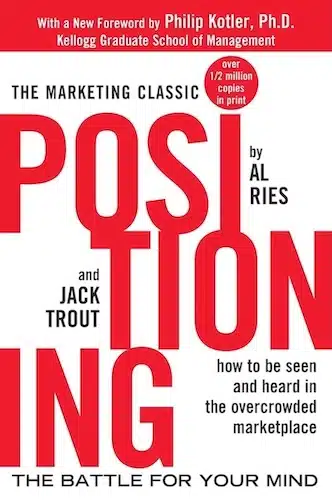
Positioning by Al Ries and Jack Trout is a groundbreaking classic that introduced the concept of “positioning” — a strategy to help brands claim a distinct place in the customer’s mind. And now it seems almost prophetic when there’s so much noise in the marketing industry and positioning is one way to cut through the clutter with focused messaging and strategic perception.
Instead of trying to introduce something completely new, the book shows you how to link your message to something your audience already understands, making it easier for them to remember and trust your brand. You’ll learn how to simplify your messaging, avoid over-promising, and take a clear stand in your category.
Who It’s For: Marketers, brand strategists, founders, or anyone looking to differentiate their product in a crowded market.
What You’ll Learn:
- How to create a “position” in your customer’s mind that reflects your strengths.
- Why simple, consistent messaging always outperforms clever or complicated branding.
- The dangers of repositioning and why it’s easier (and smarter) to carve out a new space rather than shift an existing perception.
- The importance of timing and being first in a category.
- Real-world examples of how brands like Avis, IBM, and VW succeeded (or failed) based on how they were perceived.
One Smart Takeaway: “Marketing is not a battle of products. It’s a battle of perceptions.”
2. Conversion Optimization by Khalid Saleh & Ayat Shukairy

If your website gets traffic but few sales, Conversion Optimization by Khalid Saleh and Ayat Shukairy will show you exactly how to fix that. Written by the founders of Invesp (one of the first conversion rate optimization agencies), Conversion Optimization is packed with step-by-step advice on how to turn visitors into buyers without guessing.
It doesn’t just tell you to “test everything.”
It shows you:
- What to test
- How to understand user behavior
- And why small changes like button text, page layout, or offer framing can double your conversions.
This book is ideal if you want to grow revenue without spending more on ads—by making the most of the traffic you already have.
Who It’s For: Ecommerce teams, DTC founders, SaaS marketers, growth hackers, and anyone running paid traffic or managing landing pages.
What You’ll Learn:
- How to identify where and why users drop off on your site
- How to structure a high-converting landing page, from headline to CTA
- What kinds of A/B tests actually move the needle (hint: not button colors)
- Why understanding user intent is more important than demographics
- How to use psychology, urgency, and social proof to reduce hesitation and build trust
One Smart Takeaway: “Conversion optimization isn’t about fixing your website. It’s about fixing your customer’s journey.”
3. Ogilvy on Advertising by David Ogilvy
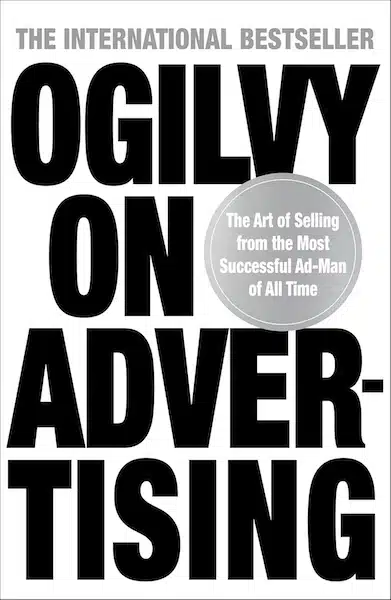
David Ogilvy, often called the “father of advertising,” built one of the world’s most iconic agencies and changed how brands speak to people. This book distills decades of his real-world experience into a surprisingly readable, even entertaining, guide for creating ads that actually drive results.
Ogilvy believed great advertising isn’t about being clever or flashy but more about selling honestly. His book teaches how you should always back your message with research, speak to real customer needs, and never underestimate your audience’s intelligence.
Even though this book was written in 1983, his lessons are still useful today:
- Keep your message clear and focused
- Use clean visuals that guide attention
- Write copy that informs, not confuses
This book is a powerful reminder that substance and clarity win over hype.
Who It’s For: Ad writers, performance marketers, founders building brand language, content strategists, and anyone who wants to write with persuasion and clarity.
What You’ll Learn:
- The anatomy of an ad that sells—from headlines and visuals to copy structure
- Why rigorous consumer research must precede any creative work.
- The lasting value of brand personality and tone of voice.
- How to advertise everything from luxury goods to charities.
- Lessons from classic campaigns by Rolls-Royce, Dove, and Hathaway shirts and why they worked.
One Smart Takeaway: “If it doesn’t sell, it isn’t creative.”
4. The 22 Immutable Laws of Marketing by Al Ries & Jack Trout
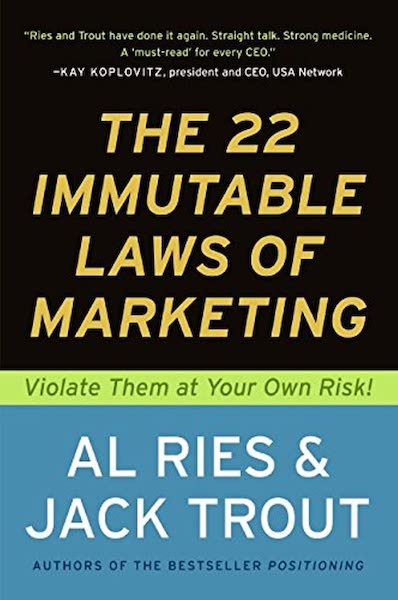
This book is like a cheat sheet for understanding how marketing really works (not just in theory, but in the minds of customers). Ries and Trout lay out 22 simple, no-nonsense laws that explain why some brands win and others quietly fade.
Each chapter is short and sharp, giving you one powerful principle—for example, why being first matters more than being better, or why trying to please everyone almost always fails.
If you’re launching something new, repositioning, or just trying to stand out, this book helps you avoid classic mistakes.
Who It’s For: Startup founders, product marketers, brand strategists, solo entrepreneurs, and anyone building go-to-market plans
What You’ll Learn:
-
Why customers remember the first in a category, not the best
-
Why perception beats reality (and how to shape it)
-
Why narrowing your focus often strengthens your brand
-
How being bold and consistent gives you long-term power
-
What not to do when you’re the #2 or #3 in a crowded space
One Smart Takeaway: “It’s better to be first in the mind than first in the marketplace.”
5. Marketing Management by Philip Kotler & Kevin Lane Keller
This book teaches you how to think like a real marketer, not just someone who runs ads or social media, but someone who understands how marketing drives the entire business.
It covers everything: how to find the right audience, how to price your product, how to position your brand, and how to build long-term customer relationships.
It’s not light reading, but if you apply even a few chapters, you’ll make smarter decisions, create better campaigns, and understand what actually grows a business.
Who It’s For: Aspiring CMOs, business students, generalists moving into marketing, and marketers who want to build strong strategic thinking
What You’ll Learn:
-
How to craft a full marketing strategy — not just isolated campaigns
-
How to segment and target the right customers
-
How pricing, promotion, and product work together (the 4Ps — and beyond)
-
How to manage and grow a brand across its lifecycle
-
How marketing connects with finance, operations, and overall business growth
One Smart Takeaway: “Marketing is not the art of finding clever ways to dispose of what you make. It is the art of creating genuine customer value.”
6. Purple Cow by Seth Godin
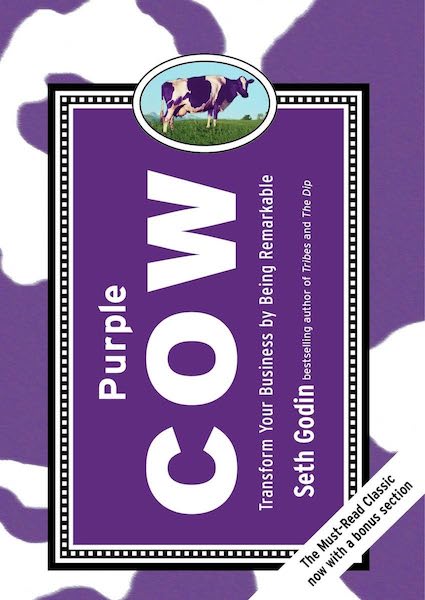
This book teaches one core idea: being “good” is no longer enough. In a crowded market, you have to be remarkable—like a purple cow in a field of regular cows. Something people notice, talk about, and remember.
Seth Godin shows you why most products fail, not because they’re bad, but because they’re boring. And why playing it safe actually puts you at more risk than standing out.
If you’re building a new product, launching a brand, or trying to grow faster, this book will shift how you think: instead of asking “How do I sell this?”, you’ll start asking, “Is this even worth talking about?”
Who It’s For: Founders, DTC brands, content creators, product marketers, and anyone struggling to get attention.
What You’ll Learn:
-
Why safe, average ideas get ignored
-
How to build products and services that stand out on their own
-
Why marketing is baked into the product, not just what comes after
-
How to find early adopters who spread your message
-
Why word-of-mouth always beats paid ads in the long run
One Smart Takeaway: “If it’s not remarkable, it’s invisible.”
II. Best Marketing Books on Consumer Behavior, Psychology & Persuasion
Great marketing starts with understanding people. These books decode how customers think, what drives them to act, and how brands can influence decisions ethically, using proven psychological principles that work across industries.
7. Influence: The Psychology of Persuasion by Robert B. Cialdini
This is one of the most practical books ever written on how to ethically influence people’s behavior in marketing, sales, or everyday life. Backed by 35+ years of research, Cialdini breaks down six principles that explain why people say yes (or no) and how you can use them to improve conversions, messaging, and trust.
If you’ve ever wondered why testimonials work, why urgency drives action, or why people follow social trends, this book gives you the science behind it all.
Who It’s For: Marketers, copywriters, founders, sales teams — anyone who needs to persuade or drive action.
What You’ll Learn:
-
How to use social proof to build instant trust (e.g., reviews, case studies)
-
Why scarcity (limited-time offers, low stock) makes people act faster
-
How authority and even simple visual cues (like uniforms or titles) increase credibility
-
Why people stick to their choices (and how to make your offer the first commitment)
-
How reciprocity—giving value first—boosts response rates
One Smart Takeaway: “People say yes more often when they feel like they owe you something — even something small.”
8. Buy.logy by Martin Lindstrom
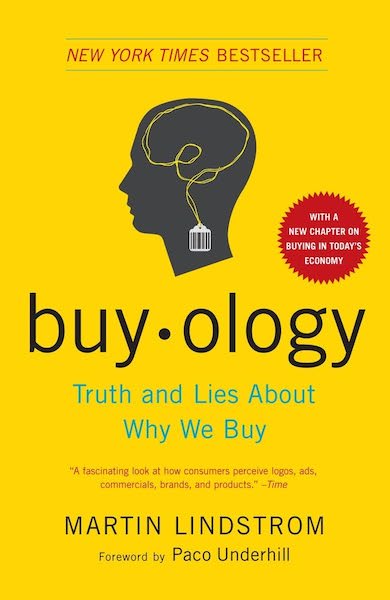
What if customers don’t actually know why they buy? Buy.logy dives into the subconscious triggers that shape purchasing decisions—many of which happen before logic even kicks in.
Lindstrom led a $7 million neuromarketing study (with brain scans) to understand how branding, emotions, visuals, and sensory cues influence what people buy and why. You’ll walk away understanding how the brain really responds to ads, logos, packaging, and messaging.
It’s especially useful if you’re working on visual branding, in-store marketing, or storytelling that needs to make an emotional impact.
Who It’s For: Brand strategists, product marketers, retail marketers, and anyone shaping customer experience.
What You’ll Learn:
-
Why emotional branding works better than logic
-
How visuals, smells, and sounds affect buyer decisions
-
Why some ads backfire — even when they test well
-
How mirror neurons, rituals, and symbolism play into brand loyalty
-
Why logos and product placement succeed or fail at a brain level
One Smart Takeaway: “People don’t buy with logic. They buy with emotion and justify it with logic later.”
9. Made to Stick by Chip Heath & Dan Heath
This book explains why some ideas catch on and others don’t even when the “bad” ideas seem to spread faster. Made to Stick gives you a clear formula for making your messages unforgettable, whether you’re writing an ad, pitching a product, or giving a talk.
If you’ve ever had a great message fall flat, this book will show you how to package your ideas so people actually remember and repeat them.
Who It’s For: Content creators, brand storytellers, marketers, educators, and anyone crafting messages that need to land.
What You’ll Learn
-
The 6 principles of sticky ideas: Simplicity, Unexpectedness, Concreteness, Credibility, Emotions, and Stories (SUCCESs model)
-
How to turn abstract ideas into visuals and stories people understand instantly
-
Why “surprise” and “curiosity gaps” are powerful tools for engagement
-
How to use real-life examples to increase believability and retention
-
How to test if your message will actually stick
One Smart Takeaway: “If you say three things, you’ve said nothing. Find the core of your message and stick to it.”
10. The Brand Gap by Marty Neumeier
This book is a crash course in how to build a brand people truly connect with not just a logo or color palette. Neumeier explains that a brand isn’t what you say it is. It’s what your customers believe it is. The gap between your business strategy and how people feel about your brand? That’s the “brand gap.”
This book helps you close that gap through clear messaging, smart design, and a unified customer experience.
Who It’s For: Brand strategists, early-stage founders, designers, creative leads, and product marketers.
What You’ll Learn:
-
Why branding is about gut feeling, not logos
-
The five disciplines of great branding: Differentiate, Collaborate, Innovate, Validate, and Cultivate
-
How to create a meaningful, consistent brand personality
-
How to align your internal culture with your external image
-
How to design brand touchpoints that leave a lasting impression
One Smart Takeaway: “A brand is not what you say it is. It’s what they say it is.”
11. The Brand Flip by Marty Neumeier
In The Brand Flip, Neumeier builds on his earlier ideas by showing how branding has changed in the age of empowered customers and social media. He argues that the power has flipped, from businesses to consumers.
Your audience now defines your brand through what they share, say, and expect. This book helps you stay relevant by focusing on customer values, community, and co-creation.
Who It’s For: Marketing teams, brand consultants, DTC founders, and anyone navigating modern customer relationships.
What You’ll Learn:
-
Why traditional top-down branding no longer works
-
How to build a tribe around shared values
-
Why customer experience is the new marketing
-
How to turn your best customers into evangelists
-
How to align culture, mission, and business goals into one clear brand story
One Smart Takeaway: “Today’s customers don’t buy brands. They join them.”
12. Zag: The #1 Strategy of High-Performance Brands by Marty Neumeier
If your brand feels like it’s getting lost in the crowd, Zag shows you how to stand out. Neumeier argues that in a world where everyone is zigging (doing the expected), your best move is to zag—that is, to go in a completely different, focused, and bold direction.
This book helps you sharpen your positioning, clarify your brand purpose, and make strategic choices that separate you from everyone else instead of blending in.
It’s short, practical, and feels more like a workshop than a lecture. Great for when you’re stuck or want a reset.
Who It’s For: Founders, brand strategists, creatives, and product teams building something from scratch or trying to rethink their market position.
What You’ll Learn:
-
Why true brand strength comes from being different, not just better
-
How to find your “onliness statement” (what your brand does that no one else can)
-
How to build your brand around a clear idea, not just features
-
Why narrowing your focus can actually widen your impact
-
How to spot the right trends — and avoid jumping on the wrong ones
One Smart Takeaway: “When everyone zigs, zag. It’s the only way to stand out.”
III. Best Marketing Books Content Marketing, Storytelling & Messaging
Forget empty content and keyword stuffing. These books teach you how to create marketing that actually informs, entertains, and builds trust, so customers come to you, not the other way around.
13. Epic Content Marketing by Joe Pulizzi
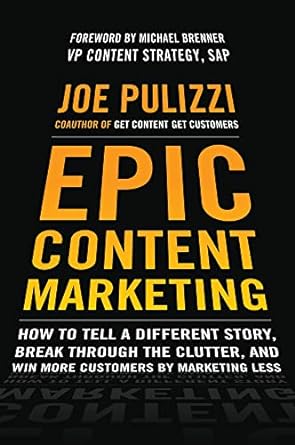
Epic Content Marketing by Joe Pulizzi is one of the best content marketing books of all time.
Joe Pulizzi founded the Content Marketing Institute (CMI), one of the leading educational resources for enterprise brands in content marketing.
It is safe to assume that Pullizzi knows a thing or two about content marketing, and in this book, he gives plenty of great advice about how to do it right.
In this book, Pulizzi lays out a full content strategy, from finding your niche to publishing consistently across channels.
If you’re tired of chasing traffic or constantly pushing ads, Epic Content Marketing helps you shift from interrupting people to becoming their go-to source of value.
Who It’s For: Content marketers, solopreneurs, brand builders, and anyone creating blogs, newsletters, or video content.
What You’ll Learn:
-
How to find your unique content angle (your “sweet spot”)
-
How to build trust through consistent, useful content
-
Why content should educate or entertain — not push sales
-
How to distribute content across channels without burning out
-
How to measure success and adjust based on results
One Smart Takeaway: “Customers don’t care about your products. They care about their problems. Create content that helps them solve those.”
14. Everybody Writes: Your Go-To Guide to Creating Ridiculously Good Content by Ann Handley
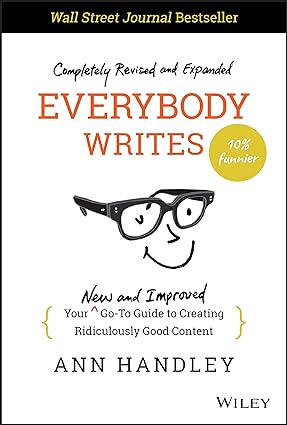
Ann Handley’s “Everybody Writes: Your Go-To Guide to Creating Ridiculously Good Content” is indispensable for anyone looking to succeed through content marketing or simply wanting to create good content.
It’s your go-to guide for writing better marketing content, whether it’s a homepage, a product description, a blog post, or even a LinkedIn update. Ann Handley makes writing feel approachable and gives you practical rules to write clearly, confidently, and in your own voice.
No fluff, no jargon—just simple, direct writing that actually works.
Who It’s For: Writers, marketers, founders, creators (or anyone who communicates online).
What You’ll Learn:
-
How to write clear, useful content that people actually read
-
Why every piece of content should start with empathy and purpose
-
Easy rules for grammar, tone, and formatting that make a big difference
-
How to write for different channels without losing your brand voice
-
How to edit like a pro (even if you’re not one)
One Smart Takeaway: “Your words are your web presence. Make them count.”
15. Building a StoryBrand by Donald Miller
This book gives you a repeatable framework to clarify your brand message using storytelling. Donald Miller shows you how to stop talking about your product features and start making your customer the hero of the story.
If your website or pitch ever leaves people confused, this book will help you fix it fast. It’s especially helpful for writing homepages, product pages, emails, and sales decks.
Who It’s For: Founders, brand leads, copywriters, marketers, and anyone struggling to explain what they do clearly.
What You’ll Learn:
-
How to simplify your message so customers actually get it
-
Why your customer is the hero and you’re just the guide
-
How to structure messaging like a story (problem -> solution -> success)
-
What to include on your homepage to drive more conversions
-
How to build a clear call-to-action that moves people forward
One Smart Takeaway: “If you confuse, you lose. People don’t buy the best product, they buy the one they understand fastest.”
16. Content Chemistry by Andy Crestodina
This is a how-to manual for content marketing that combines strategy, SEO, analytics, and writing—all in one place. Andy Crestodina breaks everything down into digestible, visual chapters with tons of templates, examples, and checklists you can apply right away.
It’s perfect if you’re doing content marketing and want it to rank, convert, and support your business goals.
Who It’s For: Content marketers, B2B brands, inbound marketers, SEO-focused teams, and anyone who wants content that performs.
What You’ll Learn:
-
How to align content with keyword strategy and search intent
-
How to write blog posts that get found and convert
-
How to promote and repurpose content across channels
-
What analytics to track (and how to improve based on them)
-
How to use visuals, structure, and formatting to improve readability
One Smart Takeaway: “Great content doesn’t just attract, it answers questions, builds trust, and moves people to act.”
17. The Copywriter’s Handbook by Robert Bly
This is a classic, no-fluff guide to writing copy that sells. Whether you’re working on ads, landing pages, emails, or brochures, Bly gives you the structure, psychology, and tactics that top copywriters use.
Think of it as a practical reference manual: clear headlines, persuasive body copy, irresistible offers, and strong calls-to-action. If you want your words to make people click, sign up, or buy, this is your guide.
Who It’s For: Copywriters, email marketers, content writers, small business owners, and anyone writing to drive action.
What You’ll Learn:
-
How to write attention-grabbing headlines and leads
-
The AIDA formula: Attention, Interest, Desire, Action
-
How to write for clarity, not cleverness
-
What makes a call-to-action actually work
-
Tips for writing long-form vs. short-form copy
One Smart Takeaway: “The purpose of a headline is to get the reader to read the first sentence. That’s it. Do that well, and you’re winning.”
18. Contagious: How to Build Word of Mouth in the Digital Age by Jonah Berger
Ever wonder why some products or ideas go viral while others flop? Berger unpacks the science of sharing—why people talk, post, and recommend certain things. He also discusses how you can design content, campaigns, or even products that people want to spread.
It’s not about luck, it’s about psychology and structure. Berger gives you the STEPPS framework (Social Currency, Triggers, Emotion, Public, Practical Value, Stories) to help your marketing become naturally shareable.
Who It’s For: Social media marketers, product teams, growth strategists, brand storytellers and anyone trying to create buzz or referrals.
What You’ll Learn:
-
Why people share content (and how to engineer that sharing)
-
How to use emotion and relatability to drive engagement
-
What makes something “talkable,” from headlines to packaging
-
Why context and timing matter more than you think
-
How storytelling builds memory and word-of-mouth
One Smart Takeaway: “People don’t share ads. They share stories, feelings, and things that make them look good.”
IV. Best Marketing Books on Social Media and Direct Response Marketing
This section focuses on results, not just reach. These books help you move beyond vanity metrics (likes, views, follows) and focus on strategies that generate real leads, sales, and business growth from social and direct marketing channels.
19. Social Media ROI by Olivier Blanchard
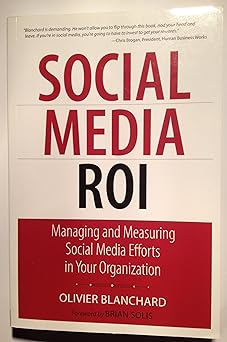
This book answers the big question most marketers avoid:
“Is social media actually driving business results?”
Blanchard takes you past fluffy engagement metrics and shows you how to plan, execute, and measure a social media strategy that supports real business goals, like leads, conversions, and customer retention.
If your social content feels busy but not effective, this book gives you a clear roadmap for tying social media back to revenue.
Who It’s For: Social media managers, digital marketers, CMOs, agency teams, and small business owners who want to prove ROI.
What You’ll Learn:
-
How to align social media with your company’s business objectives
-
How to create social KPIs that matter (not just “likes”)
-
How to track performance across channels with real metrics
-
How to justify your budget — with numbers, not just engagement screenshots
-
How to build internal support and get buy-in for your strategy
One Smart Takeaway: “Social media is not free. It takes time, effort, and money. ROI isn’t optional, it’s essential.”
20. No B.S. Guide To Direct Marketing by Dan Kennedy & Kim Walsh-Phillips
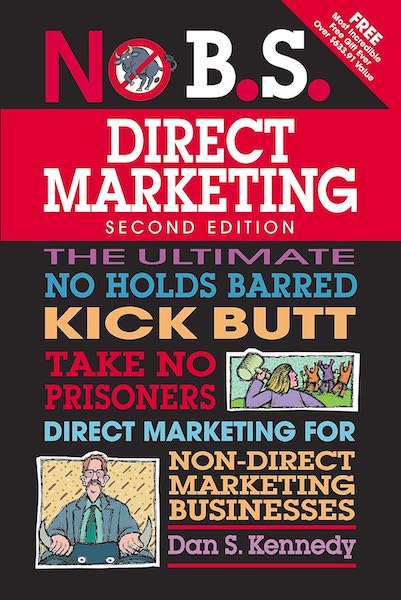
This book is a wake-up call for anyone too focused on likes and impressions. Kennedy and Walsh-Phillips show you how to use direct response marketing—content that gets leads, builds a list, and converts without wasting time on vanity metrics.
It’s straight-talking, aggressive, and full of real-world examples. Whether you’re running ads, sending emails, or building landing pages, this book helps you focus on what actually works.
Who It’s For
Email marketers, lead gen teams, solopreneurs, sales funnels pros, and anyone tired of vague marketing results.
What You’ll Learn:
-
How to craft offers that people actually respond to
-
Why likes don’t matter if they don’t lead to money
-
How to write copy that sells — not just entertains
-
How to build high-converting campaigns across email, landing pages, and social ads
-
How to track real ROI from every campaign you run
One Smart Takeaway: “You can’t take likes to the bank. Direct response marketing is about cash flow not applause.”
21. The Anatomy of Buzz by Emanuel Rosen
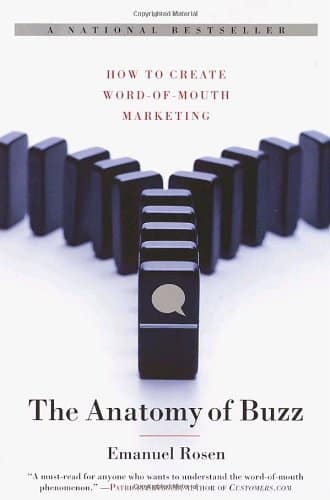
Before influencer marketing had a name, Rosen studied how word-of-mouth really spreads and how some products become “talkable” from day one. The Anatomy of Buzz breaks down the mechanics behind organic growth: how messages travel, who amplifies them, and how to engineer marketing that spreads without big budgets.
After interviewing over 150 executives, marketing leaders, and researchers who have successfully built buzz for major brands, Rosen describes the ins and outs of attracting the attention of influential first users and “big-mouth” movers and shakers.
It’s a timeless guide to earning attention instead of buying it.
Who It’s For: Early-stage founders, growth marketers, PR teams, and product marketers focused on organic reach.
What You’ll Learn:
-
What makes people talk about a product or brand
-
How to identify and engage “influencers” before social media existed
-
How to design marketing that travels by itself
-
Why trust and early adopters are key to launching with momentum
-
How customer experiences fuel referrals (or kill them)
One Smart Takeaway: “People don’t spread products. They spread stories, excitement, and value—in a way that makes them look smart.”
V. Best Marketing Books on Strategy, Innovation & Category Creation
These books go beyond day-to-day marketing. They help you think like a strategist, whether you’re defining a new market, building a long-term competitive edge, or designing products people can’t ignore. If you’re in growth, leadership, or product strategy, this section is your playbook.
22. Play Bigger by Al Ramadan, Dave Peterson, Christopher Lochhead, Kevin Maney
Most companies compete in existing markets. The best ones create new categories and dominate them. Play Bigger introduces the idea of “category design”: the process of inventing a problem only you can solve, then positioning your brand as the leader in that space.
If you’re building something disruptive or struggling to stand out, this book will completely reframe how you think about product positioning and market leadership.
Who It’s For: Startup founders, product marketers, CMOs, and innovation teams building or launching something new.
What You’ll Learn:
-
How to define a new category instead of competing in an old one
-
Why category leaders capture the most value (not just market share)
-
How to craft a powerful “point of view” that shifts customer perception
-
How to align product, brand, and company strategy around that POV
-
Why timing your launch and messaging matters more than you think
One Smart Takeaway: “The company that designs the category is the company that owns it.”
23. Competing Against Luck by Dr. Clayton Christensen, Taddy Hall, Karen Dillon, & David Duncan
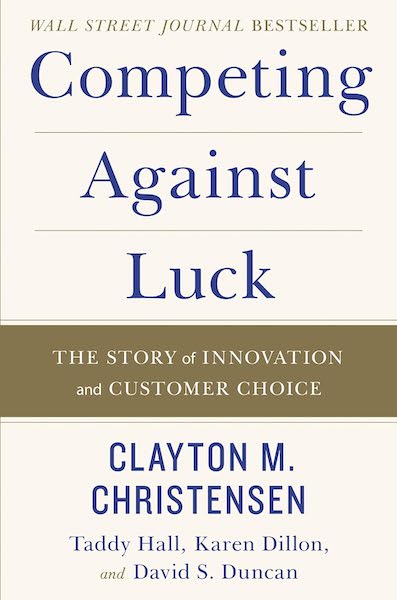
Why do people buy what they buy? It’s not random, they’re hiring products to do a job. This book introduces the Jobs-to-Be-Done (JTBD) theory—a way to understand your customer’s true needs so you can design products and marketing that match.
Instead of guessing what features will work, JTBD helps you build around real, useful customer goals. If you’re launching or refining a product, this book gives you a research-backed lens for smarter decisions.
Who It’s For: Product teams, marketers, founders, UX designers, and anyone doing customer interviews or building roadmaps.
What You’ll Learn:
-
How to uncover the hidden “job” your product is hired to do
-
Why demographics don’t explain customer behavior
-
How to avoid building features no one uses
-
How to structure interviews that reveal useful insights
-
How to link innovation to predictable growth
One Smart Takeaway: “Customers don’t buy products, they hire them to get a job done.”
24. Good Strategy, Bad Strategy by Richard P. Rumelt
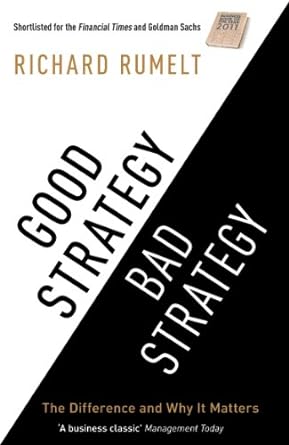
What goes into developing a marketing strategy? What’s the difference between a good and bad marketing strategy? Richard P. Rumelt’s book Good Strategy, Bad Strategy answers all these questions sufficiently.
Most business plans are filled with buzzwords and vague goals like “become the market leader” or “drive innovation.” This book shows you how to recognize empty strategy and replace it with one that’s actually executable.
Rumelt gives you a clear framework: a real strategy starts with diagnosing the core problem, choosing a guiding policy, and focusing on a few coordinated actions that address it.
Although he doesn’t specifically discuss marketing, the core principles in the book can also apply to marketing.
Who It’s For: CMOs, marketing strategists, founders, consultants, and teams creating annual plans, go-to-market strategies, or business pivots.
What You’ll Learn:
-
Why vague goals like “grow market share” aren’t strategy and what to say instead
-
How to define a “kernel of strategy”: a challenge, a policy, and a set of actions
-
How to focus resources on a single point of leverage
-
Why trying to please everyone leads to weak results
-
Real-world breakdowns of strategy at companies like Apple, Nvidia, and General Motors (what they did right and where they went wrong)
One Smart Takeaway: “The first natural advantage of good strategy is clarity: it forces you to stop lying to yourself about what really needs to be solved.”
VI. Best Marketing Books on AI, Automation & the Future
AI is changing how marketing works, from how we write and automate campaigns to how we generate leads and build customer loyalty. These are the best marketing books to understand what works now, what’s coming next, and how to stay effective in an AI-first world.
25. Marketing Artificial Intelligence by Paul Roetzer & Mike Kaput
This is the most practical, marketing-first guide to using AI in real work not just theory. It shows how tools like ChatGPT, Jasper, and predictive analytics can help you write faster, build better campaigns, automate targeting, and generate more qualified leads.
It also helps you avoid the hype and focus on what’s actually useful for marketers right now.
Who It’s For: Digital marketers, content teams, growth leads, marketing ops professionals.
What You’ll Learn:
-
Where AI fits into your marketing workflow, from planning to performance
-
How to use AI to scale content, personalize outreach, and reduce time on manual tasks
-
Which tools are worth adopting now, and what to watch out for
-
Why marketing teams need to upskill, not panic
-
How to think ethically about AI and data usage
One Smart Takeaway: “AI won’t replace marketers. But marketers who use AI will replace those who don’t.”
26. The Age of Invisible Machines by Robb Wilson
This book looks at how AI and automation are quietly changing how customers experience brands—through chatbots, voice assistants, personalized flows, and backend logic we don’t even see.
It’s especially helpful if you’re building customer journeys or thinking about how to make your brand feel smooth, fast, and smart in a world of digital noise.
Who It’s For: CX designers, UX leads, marketers working on automation, product marketing teams.
What You’ll Learn:
-
What “invisible UX” is and how AI powers it
-
How to design customer experiences that feel natural, not robotic
-
How to apply conversational AI to sales, onboarding, and support
-
How backend automation affects front-end brand experience
-
Why this shift isn’t about tools, it’s about user flow
One Smart Takeaway: “The best interface is no interface. AI-powered systems should serve without being seen.”
27. This Is Marketing by Seth Godin
In an age of AI-generated everything, this book is a grounding force. It reminds you that marketing still comes down to empathy, positioning, and trust, not hacks or volume.
It’s not about algorithms. It’s about knowing who you serve, what they need, and how to connect with them clearly and honestly. If you want your AI-assisted marketing to actually land, this gives you the human foundation to build on.
Who It’s For: Anyone building a brand, writing copy, or creating content, with or without AI tools.
What You’ll Learn:
-
Why trying to reach everyone leads to weak results
-
How to create something people genuinely want
-
How to build trust, not just traffic
-
How to speak to your smallest viable audience
-
How to stay human while everyone else automates
One Smart Takeaway: “People don’t buy products. They buy stories, belonging, and connection.”
28. The Coming Wave by Mustafa Suleyman
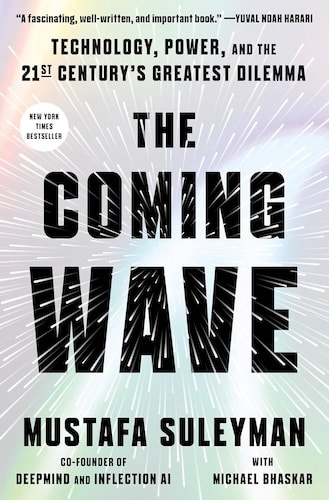
Written by the co-founder of DeepMind, this book gives you the big picture of what’s coming: not just AI tools, but a total shift in how work, power, and industries operate. It helps you think long-term: how to build resilient marketing strategies in a world that’s speeding up, getting smarter, and becoming harder to predict.
It’s not a “how-to”—it’s a strategic lens for leaders who want to stay relevant.
Who It’s For: Founders, CMOs, product strategists, brand thinkers who want a long-view perspective
What You’ll Learn:
-
How AI (and synthetic tech) will reshape every business function
-
Why speed and adaptiveness are now survival skills
-
The risks of unregulated AI and how to market ethically
-
Why trust and transparency will be a competitive edge
-
How to lead in a world where disruption is constant
One Smart Takeaway: “In the AI age, your edge won’t come from tools, it’ll come from how fast you can adapt.”
29. AI Snake Oil by Arvind Narayanan & Sayash Kapoor
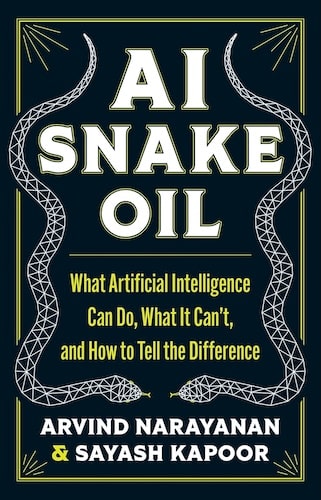
Most marketers are being sold AI tools they barely understand, with promises like “automated copywriting,” “personalized at scale,” or “predictive magic.”
This book helps you separate real AI from marketing fluff.
Written by two Princeton researchers, AI Snake Oil breaks down the difference between what AI can do well (e.g. generating content, recognizing patterns) and what it struggles with (e.g. understanding meaning, making decisions). If you’re evaluating AI vendors or tools, this book gives you the mental filter to avoid wasting time and budget.
Who It’s For: CMOs, marketing leads, consultants, growth teams, and anyone investing in AI-powered marketing tools or agencies.
What You’ll Learn:
-
Why many “AI-powered” tools are overhyped or misleading
-
The difference between narrow, useful AI and “general intelligence” hype
-
How to ask the right questions before buying or implementing AI tools
-
Where AI adds value in marketing workflows and where it doesn’t
-
Ethical red flags to look for when using customer data in AI systems
One Smart Takeaway: “You don’t need to fear AI. But you do need to question what it claims to do, especially when it comes with a subscription fee.”
30. The AI Marketing Canvas by Raj Venkatesan & Jim Lecinski
This is a strategic and practical guide written by a marketing professor and a former Google VP. It lays out a five-stage framework to integrate AI into marketing: from data collection to personalized experiences and predictive insights. It’s clear, credible, and made for marketing leaders.
Who It’s For: CMOs, growth marketers, brand strategists, and senior marketers building AI-ready teams.
What You’ll Learn:
-
A step-by-step model for AI integration across the customer journey
-
How to personalize campaigns using customer behavior data
-
How to identify quick wins with AI before full transformation
-
Use cases for content, media, pricing, and loyalty
-
How to align AI with brand strategy and ROI goals
One Smart Takeaway: “The marketers who will win with AI are the ones who treat it as a partner, not just a tool.”
31. Mastering Marketing Agility by Andrea Fryrear
In the era of AI and ongoing algorithmic updates, speed and adaptability are crucial. This book teaches you how to build agile marketing teams that can test faster, respond to insights in real-time, and evolve messaging on the fly—something tools like ChatGPT and Claude make easier, but only if your team is structured right.
Who It’s For: Marketing ops leaders, in-house teams, startup CMOs, agency managers.
What You’ll Learn:
-
How to implement agile workflows tailored for marketing (not borrowed from software dev)
-
How to prioritize quickly without drowning in tasks
-
How to create feedback loops that adapt messaging in near real time
-
How to balance experimentation with long-term brand strategy
-
Tools, templates, and rituals for keeping teams aligned and fast
One Smart Takeaway: “AI makes speed possible. Agility makes it valuable.”
How to Apply What You Learn From the Best Marketing Books: 5 Proven Marketing Moves for 2025
Reading great marketing books is valuable, but applying what they teach is what drives real results. Based on the key insights from this list of best marketing books, here are five high-impact marketing strategies you can use to achieve your marketing goals in 2025:
1. Set Measurable Goals and Build Strategy Backward
Books like “Good Strategy, Bad Strategy” and “Marketing Management” emphasize that effective marketing starts with clarity.
That means setting measurable goals (not vague aspirations), identifying the biggest obstacle in your way, and creating a focused plan to address it.
For example, instead of saying “We want to grow brand awareness,” define a measurable goal tied to business impact. Something like, “We want to increase demo requests from qualified leads by 30% in Q3.”
Once the goal is clear, define the challenge, like “Our current landing page converts at just 1.2% and traffic quality is inconsistent.”
Now build a strategy that addresses it:
-
Focus the media budget on high-intent search terms
-
A/B test new landing page layouts
-
Update CTAs based on scroll and click behavior
This is the difference between random activity and strategic marketing.
2. Make Your Brand Easy to Understand and Easy to Share
In Contagious, The Brand Flip, and Ogilvy on Advertising, a consistent message emerges: people don’t just buy products, they spread stories that reflect who they are.
To stand out, stop describing your product in features. Instead, craft a simple message that resonates with the customer’s self-image and inspires them to share it.
For example, instead of “We offer scalable CRM integrations,” say “We help fast-moving sales teams close faster with tools that feel like second nature.”
Create messages that are:
-
Emotionally relevant
-
Socially shareable (makes them look smart or helpful)
-
Instantly clear
Then bake those into your homepage headline, email intros, and product explainer.
3. Create Content That Solves Specific Problems
Books like Epic Content Marketing, Everybody Writes, and Made to Stick all highlight that content isn’t just filler; it builds trust, solves real problems, and nudges people toward action.
For example, instead of “5 Social Media Tips,” write “How B2B Brands Can Get Leads from LinkedIn Without Paid Ads.” Then break it down with steps, visuals, and a soft CTA to your demo or resource.
What works:
-
Narrow focus
-
Clear structure
-
Immediate value
-
A useful next step
Wrapping Up: Key Takeaways from the Best Marketing Books!
So, there you have it! Diving into some of the best marketing books is like giving yourself a masterclass in cutting-edge marketing strategies. Some even help you hone your business strategy in everyday life.
Whether it’s gaining deeper insights into consumer behavior, mastering content creation, or leveraging social media, each book packs a powerful punch of knowledge that can help grow your business with a winning and successful marketing strategy.
And remember the marketing tips for 2025! These strategies are fresh and geared to keep you ahead of the curve. So, pick up some marketing books based on your industry and interest, use what you learn, do market research, and watch your business grow.
Resources You’ll Love.
1. What are the 4 Ps of Marketing? Understanding the Basics
2. How to Manage a Remote Team in a Way that Drives Business Growth
3. How To Build Thought Leadership From Scratch For Your Business
4. 12 Entrepreneurship Lessons Every Entrepreneur Must Know
5. 13 Best Product Marketing Books in 2023
Best Marketing Books FAQs
What are the Best Books on Marketing?
Some of the best marketing books include Influence by Robert Cialdini, Building a StoryBrand by Donald Miller, Made to Stick by Chip and Dan Heath, Contagious by Jonah Berger, and This Is Marketing by Seth Godin. These books cover everything from psychology to branding and how to create messages that stick.
What are the best digital marketing books?
For digital marketing, top books include Digital Marketing for Dummies by Ryan Deiss and Russ Henneberry, Killing Marketing by Joe Pulizzi and Robert Rose, Jab, Jab, Jab, Right Hook by Gary Vaynerchuk, The Art of SEO by Eric Enge, and The 1-Page Marketing Plan by Allan Dib. These books focus on content, social media, SEO, and online strategies that drive results.
What is the Best Marketing Book of All Time?
There’s no single “best” marketing book, but Influence: The Psychology of Persuasion by Robert Cialdini is one of the most widely recommended. It breaks down the six principles of persuasion and is a must-read for anyone in marketing, sales, or business.
Which book is Best for Sales and Marketing?
If you want a book that covers both sales and marketing, The Ultimate Sales Machine by Chet Holmes is a great choice. It teaches how to generate leads, close deals, and create a marketing system that consistently brings in customers. Another solid option is Sell Like Crazy by Sabri Suby, which blends digital marketing with sales psychology.
What is the #1 Rule in Marketing?
The #1 rule in marketing is to know your audience. If you don’t understand who they are, what they want, and how they make decisions, no strategy, tool, or ad campaign will work. Great marketing starts with deep customer insights and speaking directly to their needs.
What are the Characteristics of Great Marketing Books?
Great marketing books are practical, data-driven, and based on real-world experience. They provide actionable strategies, clear frameworks, and case studies that show what works and what doesn’t. They also focus on timeless principles rather than short-lived trends, making them valuable long-term. A great marketing book should challenge your thinking, improve your skills, and be easy to apply in real business scenarios.
What is the Importance of Reading Marketing Books?
Reading marketing books helps you stay ahead of industry trends, refine your strategies, and learn from the successes (and failures) of top marketers. They provide deeper insights than blog posts or social media content and give you proven frameworks to improve your campaigns. Whether you’re in branding, digital marketing, or sales, continuous learning through books keeps you sharp and helps you make smarter marketing decisions.

